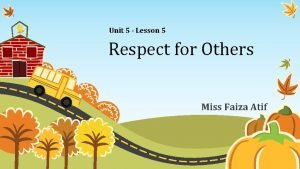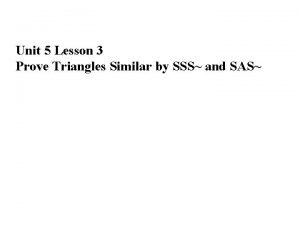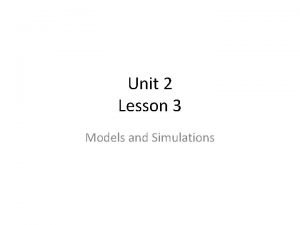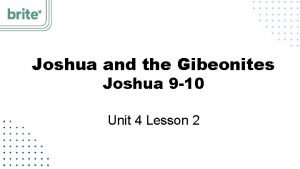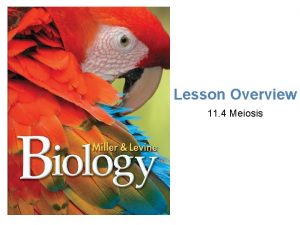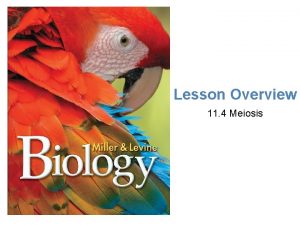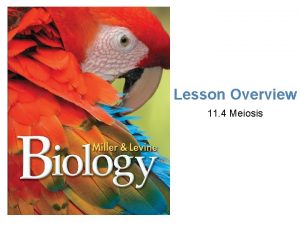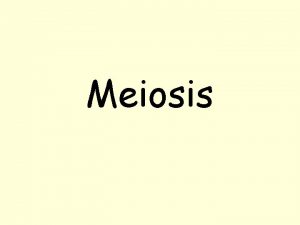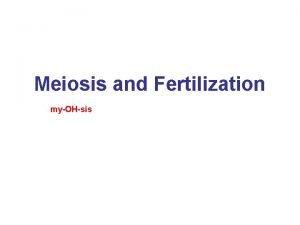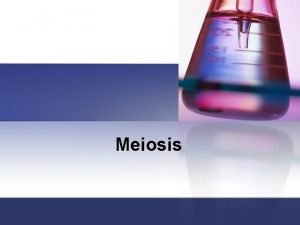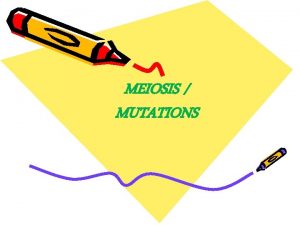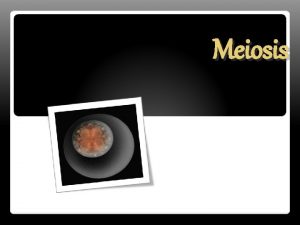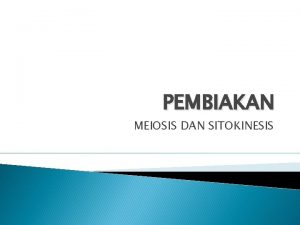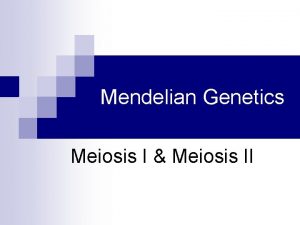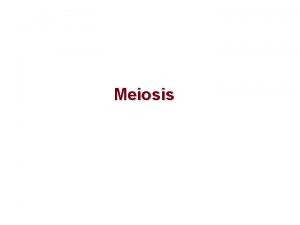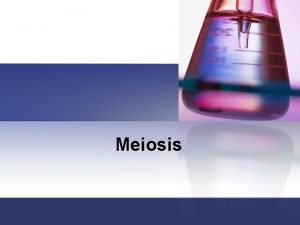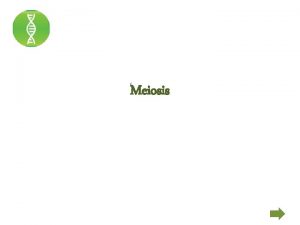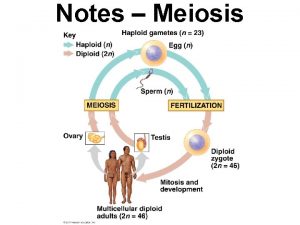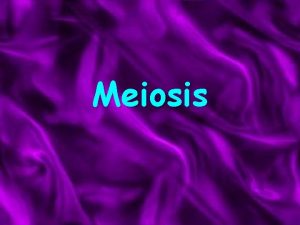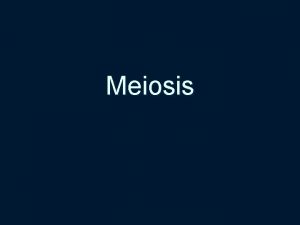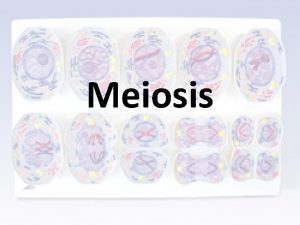Lesson Overview Unit 7 Meiosis Lesson Overview Meiosis


















































- Slides: 50

Lesson Overview Unit 7: Meiosis

Lesson Overview Meiosis Chromosome Number Chromosomes—those strands of DNA and protein inside the cell nucleus— are the carriers of genes. The genes are located in specific positions on chromosomes.

Lesson Overview Meiosis Haploid Cells Some cells contain only a single set of chromosomes, and therefore a single set of genes. Such cells are haploid, meaning “one set. ” The gametes(sex cells) of sexually reproducing organisms are haploid. For fruit fly gametes, the haploid number is 4, which can be written as N = 4. IN HUMANS N=23

Lesson Overview Meiosis Diploid Cells A body cell in an adult fruit fly has eight chromosomes, as shown in the figure. Four of the chromosomes come from its male parent, and four come from its female parent. These two sets of chromosomes are homologous, meaning that each of the four chromosomes from the male parent has a corresponding chromosome from the female parent.

Lesson Overview Meiosis Diploid Cells A cell that contains both sets of homologous chromosomes is diploid (from mom and dad), meaning “two sets. ” The diploid number of chromosomes is sometimes represented by the symbol 2 N. For the fruit fly, the diploid number is 8, which can be written as 2 N = 8, where N represents twice the number of chromosomes in a sperm or egg cell. Diploid number in humans is 2 N=46

Lesson Overview Meiosis Phases of Meiosis is a process in which the number of chromosomes per cell is cut in half through the separation of homologous chromosomes in a diploid cell. Meiosis follows mitosis. By the end of meiosis, the diploid cell becomes four haploid cells, each containing half the chromosomes as parent cell.

Lesson Overview Meiosis Just prior to meiosis, the cell undergoes a round of chromosome replication called interphase II. Each replicated chromosome consists of two identical chromatids joined at the center.

Lesson Overview Meiosis Prophase II The cells begin to divide, and the chromosomes pair up, forming a structure called a tetrad, which contains four chromatids. As homologous chromosomes pair up and form tetrads, they undergo a process called crossing-over. Crossing-over is important because it produces new combinations of alleles in the cell (genetic diversity).

Lesson Overview Meiosis Metaphase II, Anaphase II, and Telophase II During metaphase II, paired homologous chromosomes line up across the center of the cell. During anaphase II, spindle fibers pull each homologous chromosome pair toward opposite ends of the cell. When anaphase II is complete, the separated chromosomes cluster at opposite ends of the cell. During telophase II, a nuclear membrane forms around each cluster of chromosomes.

Lesson Overview Meiosis Comparing Meiosis and Mitosis is a form of asexual reproduction, whereas meiosis is an early step in sexual reproduction. There are three other ways in which these two processes differ.

Lesson Overview Meiosis 1. Replication and Separation of Genetic Material In mitosis, when the two sets of genetic material separate, each daughter cell receives one complete set of chromosomes.

Lesson Overview Meiosis 1. Replication and Separation of Genetic Material In meiosis, homologous chromosomes line up and then move to separate daughter cells. As a result, the two alleles for each gene segregate from each other and end up in different cells. The sorting and recombination of genes in meiosis result in a greater variety of possible gene combinations than could result from mitosis

Lesson Overview Meiosis 2. Changes in Chromosome Number Mitosis does not normally change the chromosome number of the original cell. Meiosis reduces the chromosome number by half.

Lesson Overview Meiosis 2. Changes in Chromosome Number A diploid cell that enters mitosis with four chromosomes will divide to produce two diploid daughter cells, each of which also has four chromosomes.

Lesson Overview Meiosis 2. Changes in Chromosome Number On the other hand, a diploid cell that enters meiosis with four chromosomes will pass through two meiotic divisions to produce four haploid gamete cells, each with only two chromosomes.

Lesson Overview Meiosis 3. Number of Cell Divisions Mitosis is a single cell division, resulting in the production of two genetically identical diploid daughter cells.

Lesson Overview Meiosis 3. Number of Cell Divisions Meiosis requires two rounds of cell division, and, in most organisms, produces a total of four genetically different haploid daughter cells.

Lesson Overview Unit 7: Mendel and Punnett Square

Lesson Overview Meiosis The Experiments of Gregor Mendel Every living thing—plant or animal, microbe or human being—has a set of characteristics inherited from its parent or parents. The delivery of characteristics from parent to offspring is called heredity. The scientific study of heredity, known as genetics, is the key to understanding what makes each organism unique. The modern science of genetics was founded by an Austrian monk named Gregor Mendel carried out his work with ordinary garden peas, partly because peas are small and easy to grow. A single pea plant can produce hundreds of offspring By using peas, Mendel was able to carry out, in just one or two growing seasons, experiments that would have been impossible to do with humans and that would have taken decades—if not centuries—to do with other large animals

Lesson Overview Meiosis Genes and Alleles When doing genetic crosses, we call the original pair of plants the P, or parental, generation Their offspring are called the F 1, or “first filial, ” generation. For each trait studied in Mendel’s experiments, all the offspring had the characteristics of only one of their parents, as shown in the table In each cross, the nature of the other parent, with regard to each trait, seemed to have disappeared

Lesson Overview Meiosis Genes and Alleles From these results, Mendel drew two conclusions. His first conclusion formed the basis of our current understanding of inheritance. An individual’s characteristics are determined by factors that are passed from one parental generation to the next. Scientists call the factors that are passed from parent to offspring genes. Each of the traits Mendel studied was controlled by one gene that occurred in two contrasting varieties. These gene variations produced different expressions, or forms, of each trait. The different forms of a gene are called alleles

Lesson Overview Meiosis Dominant and Recessive Traits Mendel’s second conclusion is called the principle of dominance. This principle states that some alleles are dominant and others are recessive. An organism with at least one dominant allele for a particular form of a trait will exhibit that form of the trait. An organism with a recessive allele for a particular form of a trait will exhibit that form only when the dominant allele for the trait is not present.

Lesson Overview Meiosis Dominant and Recessive Traits In Mendel’s experiments, the allele for tall plants was dominant and the allele for short plants was recessive Each of the traits Mendel studied was controlled by one gene that occurred in two contrasting varieties. These gene variations produced different expressions, or forms, of each trait. The different forms of a gene are called alleles. In Mendel’s experiments, the allele for tall plants was dominant and the allele for short plants was recessive. Likewise, the allele for yellow seeds was dominant over the recessive allele for green seeds

Lesson Overview Meiosis Genotype and Phenotype Every organism has a genetic makeup as well as a set of observable characteristics. All of the tall pea plants had the same phenotype, or physical traits( or what they look like) They did not, however, have the same genotype, or genetic makeup( or read genotype backwards= type O genes) Examples of different genotypes are: Tt, TT, and tt. The genotype of an organism is inherited, whereas the phenotype is formed as a result of both the environment and the genotype. Two organisms may have the same phenotype but different genotypes.

Lesson Overview Meiosis Probability and Punnett Squares Whenever Mendel performed a cross with pea plants, he carefully categorized and counted the offspring. For example, whenever he crossed two plants that were hybrid for stem height (Tt), about three fourths of the resulting plants were tall and about one fourth were short.

Lesson Overview Meiosis Probability and Punnett Squares If you flip a coin three times in a row, what is the probability that it will land heads up every time? Each coin flip is an independent event, with a one chance in two probability of landing heads up Therefore, the probability of flipping three heads in a row is: 1/2 × 1/2 = 1/8 As you can see, you have 1 chance in 8 of flipping heads three times in a row. Past outcomes do not affect future ones. Just because you’ve flipped 3 heads in a row does not mean that you’re more likely to have a coin land tails up on the next flip.

Lesson Overview Meiosis Using Segregation to Predict Outcomes Organisms that have two identical alleles for a particular gene—TT or tt in this example—are said to be homozygous Organisms that have two different alleles for the same gene—such as Tt—are heterozygous. .

Lesson Overview Meiosis Using Punnett Squares One of the best ways to predict the outcome of a genetic cross is by drawing a simple diagram known as a Punnett squares allow you to predict the genotype and phenotype combinations in genetic crosses using mathematical probability.

Lesson Overview Meiosis How To Make a Punnett Square Draw a table with enough spaces for each pair of gametes from each parent. Enter the genotypes of the gametes produced by both parents on the top and left sides of the table.

Lesson Overview Meiosis How To Make a Punnett Square Fill in the table by combining the gametes’ genotypes. Determine the genotypes and phenotypes of each offspring. Calculate the percentage of each. In this example, three fourths of the chicks will have large beaks, but only one in two will be heterozygous

Lesson Overview Meiosis The Two-Factor Cross: F 1 Mendel crossed true-breeding plants that produced only round yellow peas with plants that produced wrinkled green peas. The round yellow peas had the genotype RRYY, which is homozygous dominant The wrinkled green peas had the genotype rryy, which is homozygous recessive.

Lesson Overview Meiosis The Two-Factor Cross: F 1 All of the F 1 offspring produced round yellow peas. These results showed that the alleles for yellow and round peas are dominant over the alleles for green and wrinkled peas. The Punnett square shows that the genotype of each F 1 offspring was Rr. Yy, heterozygous for both seed shape and seed color.

Lesson Overview Meiosis The Two-Factor Cross: F 2 Mendel then crossed the F 1 plants to produce F 2 offspring. Mendel observed that 315 of the F 2 seeds were round and yellow, while another 32 seeds were wrinkled and green—the two parental phenotypes. But 209 seeds had combinations of phenotypes, and therefore combinations of alleles, that were not found in either parent

Lesson Overview Meiosis The Two-Factor Cross: F 2 The alleles for seed shape segregated independently of those for seed color. Genes that segregate independently—such as the genes for seed shape and seed color in pea plants—do not influence each other’s inheritance.

Lesson Overview Meiosis The Two-Factor Cross: F 2 Mendel’s experimental results were very close to the 9: 3: 3: 1 ratio that the Punnett square shown predicts. Mendel had discovered the principle of independent assortment. The principle of independent assortment states that genes for different traits can segregate independently during gamete formation.

Lesson Overview Meiosis A Summary of Mendel’s Principles Alleles for different genes usually segregate independently of each other.

Lesson Overview Unit 7: Pedigrees

Lesson Overview Meiosis Human Pedigrees To analyze the pattern of inheritance followed by a particular trait, you can use a chart, called a pedigree, which shows the relationships within a family. A pedigree shows the presence or absence of a trait according to the relationships between parents, siblings, and offspring.

Lesson Overview Meiosis Human Pedigrees This diagram shows what the symbols in a pedigree represent. Circles represent “girls. ” Squares represent “boys. ”

Lesson Overview Meiosis Human Pedigrees This pedigree shows how one human trait—a white lock of hair just above the forehead—passes through three generations of a family. The allele for the white forelock trait is dominant.

Lesson Overview Meiosis Human Pedigrees At the top of the chart is a grandfather who had the white forelock trait. Two of his three children inherited the trait. Three grandchildren have the trait, but two do not.

Lesson Overview Meiosis Human Pedigrees Because the white forelock trait is dominant, all the family members in the pedigree lacking this trait must have homozygous recessive alleles. One of the grandfather’s children lacks the white forelock trait, so the grandfather must be heterozygous for this trait.

Lesson Overview Inheritance Patterns

Lesson Overview Meiosis Beyond Dominant and Recessive Alleles Despite the importance of Mendel’s work, there are important exceptions to most of his principles. In most organisms, genetics is more complicated, because the majority of genes have more than two alleles. In addition, many important traits are controlled by more than one gene. Mendel’s principles alone cannot predict traits that are controlled by multiple alleles or multiple genes.

Lesson Overview Meiosis Incomplete Dominance The F 1 generation produced by a cross between red-flowered (RR) and white-flowered (WW) plants consists of pink-colored flowers (RW), as shown In this case, neither allele is dominant. Cases in which one allele is not completely dominant over another are called incomplete dominance.

Lesson Overview Meiosis Codominance Cases in which the phenotypes produced by both alleles are clearly expressed are called codominance. For example, in certain varieties of chicken, the allele for black feathers is codominant with the allele for white feathers.

Lesson Overview Meiosis Multiple Alleles A single gene can have many possible alleles. A gene with more than two alleles is said to have multiple alleles. Many genes have multiple alleles, including the human genes for blood type. This chart shows the percentage of the U. S. population that shares each blood group.

Lesson Overview Meiosis Polygenic Traits controlled by two or more genes are said to be polygenic traits. Polygenic means “many genes. ” Polygenic traits often show a wide range of phenotypes. The variety of skin color in humans comes about partly because more than four different genes probably control this trait.

Lesson Overview Meiosis Sex-Linked Inheritance The genes located on the X and Y chromosomes show a pattern of inheritance called sex-linked. A sex-linked gene is a gene located on a sex chromosome. Genes on the Y chromosome are found only in males and are passed directly from father to son. Genes located on the X chromosome are found in both sexes, but the fact that men have just one X chromosome leads to some interesting consequences.

Lesson Overview Meiosis Sex-Linked Inheritance For example, humans have three genes responsible for color vision, all located on the X chromosome. In males, a defective allele for any of these genes results in colorblindness, an inability to distinguish certain colors. The most common form, red-green colorblindness, occurs in about 1 in 12 males. Among females, however, colorblindness affects only about 1 in 200. In order for a recessive allele, like colorblindness, to be expressed in females, it must be present in two copies—one on each of the X chromosomes. The recessive phenotype of a sex-linked genetic disorder tends to be much more common among males than among females.
 Meiosis i vs meiosis ii
Meiosis i vs meiosis ii Meisis 1 and 2
Meisis 1 and 2 Meiosis and genetic variation usatestprep
Meiosis and genetic variation usatestprep What is the difference between mitosis and meiosis 2
What is the difference between mitosis and meiosis 2 Study guide chapter 10 section 1 meiosis
Study guide chapter 10 section 1 meiosis Chapter 10 section 1 meiosis
Chapter 10 section 1 meiosis Telophase
Telophase Unit 10, unit 10 review tests, unit 10 general test
Unit 10, unit 10 review tests, unit 10 general test Hyp opp adj
Hyp opp adj How to write informal email
How to write informal email Chapter 9 lesson 2 photosynthesis an overview
Chapter 9 lesson 2 photosynthesis an overview Lesson overview
Lesson overview Surplus keuangan adalah
Surplus keuangan adalah English unit conversion
English unit conversion Unit 1 test algebra 2 answers
Unit 1 test algebra 2 answers Contoh soal perhitungan unit cost rumah sakit
Contoh soal perhitungan unit cost rumah sakit Unit process and unit operation
Unit process and unit operation Difference between unit process and unit operation
Difference between unit process and unit operation Kerangka konseptual akuntansi pemerintahan
Kerangka konseptual akuntansi pemerintahan Unit 9 lesson 4
Unit 9 lesson 4 Unit 7: lesson 5 - review questions
Unit 7: lesson 5 - review questions Lesson 4 parameters and return make rock paper scissors
Lesson 4 parameters and return make rock paper scissors Code.org unit 7 lesson 3
Code.org unit 7 lesson 3 Unit 7 lesson 1
Unit 7 lesson 1 Quadrilaterals and parallelograms
Quadrilaterals and parallelograms Unit 6 lesson 1 permutations and combinations
Unit 6 lesson 1 permutations and combinations Unit 6: lesson 4 - fast start
Unit 6: lesson 4 - fast start Unit 6 lesson 2
Unit 6 lesson 2 Chapter 16 lesson 3 the female reproductive system
Chapter 16 lesson 3 the female reproductive system Unit 5: lesson 6 - review questions
Unit 5: lesson 6 - review questions Unit 5 lesson 5
Unit 5 lesson 5 Unit 5 lesson 3 geometry
Unit 5 lesson 3 geometry Unit 5 lesson 10
Unit 5 lesson 10 Unit 4 lesson 1 decision making
Unit 4 lesson 1 decision making Math models unit 9
Math models unit 9 Unit of beauty
Unit of beauty Unit 13 lesson 6
Unit 13 lesson 6 Variables and expressions 1-1 answer key
Variables and expressions 1-1 answer key Unit 7 lesson 2 simplify expressions
Unit 7 lesson 2 simplify expressions Unit 5 macroeconomics lesson 2 activity 45 answer key
Unit 5 macroeconomics lesson 2 activity 45 answer key Unit 4: toxins lesson 78 worksheet answers
Unit 4: toxins lesson 78 worksheet answers Unit 1 alchemy lesson 20 worksheet answers
Unit 1 alchemy lesson 20 worksheet answers Unit 6 lesson 6 surface areas and volumes of spheres
Unit 6 lesson 6 surface areas and volumes of spheres Non vertex angles
Non vertex angles Moderation in a healthful eating plan involves
Moderation in a healthful eating plan involves Horizontal asymptote
Horizontal asymptote Joshua law unit 7 lesson 1
Joshua law unit 7 lesson 1 Economics unit 2 lesson 1
Economics unit 2 lesson 1 Unit 8 lesson 4 name triangles
Unit 8 lesson 4 name triangles The frog prince by stevie smith
The frog prince by stevie smith Economics unit 1 lesson 6
Economics unit 1 lesson 6






























